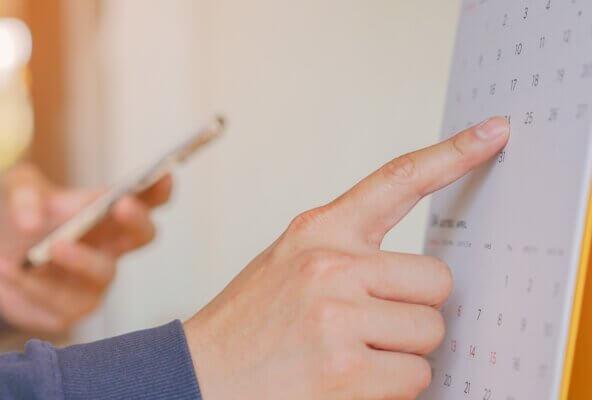9 patient appointment reminder templates that work
Use these tried-and-true appointment reminder templates to keep your schedule full, reduce no-shows, and elevate the patient experience.

Overview
- Appointment reminders via phone, email, and text message can significantly reduce no-shows and late cancellations.
- Reminders should include appointment details and instructions for rescheduling or cancelling.
- Schedule reminders to be sent in a reasonable cadence such as 3 days before, 1 day before, and day-of the appointment.
- When selecting an automated reminder system, look for customization of reminders, multi-channel communication, two-way engagement with patients, demographic appropriateness, and easy appointment confirmation options.
No one likes an appointment no-show. Not only is it frustrating for your providers, but consistent late arrivals or missed appointments can significantly impair your practice performance, patient experience, and, of course — profitability.
A tried-and-true solution for minimizing no-shows and late arrivals? Automatic appointment reminders.
Tebra’s recent survey found that 80% of medical providers used appointment reminders to reduce no-shows.
If you’re looking to start using automated reminders or want to give your existing messages a refresh, we’re here to help. We’ve rounded up some easily adjustable patient appointment reminder templates for phone, email, and text to help your patients stay on top of their scheduled appointments.
Download your free resource now
Access it instantly — just complete the form

What makes a great patient appointment reminder?
So, how do you remind patients of appointments? Sending appointment reminders can feel a bit like you’re pestering your patients. But in reality, medical appointments are often booked weeks, if not months, in advance. And with busy lives, things like medical appointments can sometimes fall off the radar. Providing reminders gives your patients another opportunity to ensure they make it to their appointments on time.
When sent at a reasonable cadence — such as 3 days prior, the day before, and the day of — most patients actually appreciate the reminders. Plus, they help you keep your calendar full while retaining patients, a win-win.
There are many ways to send reminders, such as by phone, email, or text, but with any channel, here are some essential details to include:
- Name of your practice
- Name of the provider (where applicable)
- Date and time of the appointment
- Type of appointment (where applicable)
- Location or address
- How to confirm, cancel, or reschedule the appointment
Tip: Use a mix of phone, email, and text messaging reminders to make sure that your patients get the reminders they need without overwhelming them. You may also want to consider an opportunity for patients to confirm their appointment at any of these touchpoints so they can opt out of receiving additional reminders.
Automated patient reminder call scripts
Phone calls are one of the oldest tricks in the book for appointment reminders. In years past, practices would often have administrative staff who were responsible for calling patients to confirm their appointments.
While some practices still opt for the more personal or manual approach, you can now easily automate your reminder phone calls based on your appointment schedule.
“You can now easily automate your reminder phone calls based on your appointment schedule.”
Here are some simple scripts you can use for your automated patient reminder calls.
3 days before an appointment
By calling a few days prior to a scheduled appointment, your call can serve as both a reminder of the appointment and of your cancellation policy. This way, if there does happen to be a conflict, your practice has the time to make appropriate arrangements.
Hi [PATIENT],
This is [PRACTICE NAME] calling to remind you of your upcoming appointment with [PROVIDER] at [TIME] ON [DATE].
If you’re no longer able to make this appointment, please call us back at [PHONE NUMBER] at least 24 hours before your appointment, and we’d be happy to help you reschedule.
Thank you, and we look forward to seeing you then.
The day before an appointment
Many individuals take the time to plan their next day’s schedule. So, a reminder the day before can help ensure the appointment stays on your patient’s radar. Take this opportunity to remind them of anything they need to know about their appointment — for example, parking or any other details.
Hi [PATIENT],
This is [PRACTICE NAME] calling to confirm your appointment for [SERVICE] with [PROVIDER] tomorrow at [TIME].
We recommend arriving 15 minutes ahead of your appointment so you have time to park and fill out any paperwork needed.
If you have any questions, please give us a call at [PHONE NUMBER].
Thank you, and we look forward to seeing you tomorrow.
The day of an appointment
A reminder on the day of an appointment can be a helpful last-minute reminder for patients who tend to run behind.
Hi [PATIENT],
This is [PRACTICE NAME] calling to remind you of your appointment with [PROVIDER] today at [TIME].
Thank you, and we look forward to seeing you later today.
While phone calls are a great way to communicate with patients, phone call reminders can be a bit tricky. As most of us get inundated with spam calls, it can be difficult to reach patients over the phone.
In fact, a Pew Research study found that 67% of Americans don’t answer their phone to unknown callers. However, most still tend to check their voicemails, so it’s best to leave a message if your call isn’t answered.
“According to a study, 67% of Americans don’t answer their phone to unknown callers.”
If you’re finding that your phone calls and voicemails are going ignored, it’s worth incorporating other types of appointment reminders, such as emails and text messages, to your reminder cadence.
Templates for automated reminder emails for appointments
Emails have become a standard form of communication between patients and practices. Most individuals have an email address that they check regularly, whether it’s for personal or business matters.
Automated emails are a wonderful way to remind patients of their appointments. It can feel less intrusive than a phone call, and it’s easy to include any important details in writing or link to resources, like online patient education on what to do or avoid before light surgery.
So, how do you email a friendly appointment reminder? Here are 3 simple templates for automated reminder emails for appointments.
3 days before an appointment
As an appointment date approaches, you can send a simple email reminding your patient of the details.
Similar to the phone call, you can provide an option for rescheduling online or canceling their appointment. This way, patients know they are expected to communicate schedule changes rather than skipping appointments altogether.
Subject: Your appointment is coming up.
Hi [PATIENT],
This is a friendly reminder of your upcoming appointment on [DATE] at [TIME] with [PROVIDER].
If you need to cancel or reschedule your appointment, please click here [LINK] or contact our office at [PHONE] or [EMAIL], and we’d be happy to help.
Thank you, and we look forward to seeing you then.
Sincerely,
[PRACTICE NAME]
[ADDRESS]
The day before an appointment with a confirmation request
The day before an appointment, you can send a reminder with a request to confirm.
“Including a confirmation option in your automated reminder emails is helpful.”
Including a confirmation option in your automated reminder emails for appointments is an easy way to ensure that a reminder has been received and that your patient is still planning to attend.
Subject: REMINDER: Appointment tomorrow
Hi [PATIENT],
It’s almost time for your appointment:
[DATE] at [TIME]
With [PROVIDER]
[ADDRESS]
Please confirm your appointment here: [LINK]
If you have any other questions, please contact us at [EMAIL] or [PHONE].
Sincerely,
[PRACTICE NAME]
The day of an appointment
A quick last-minute reminder is helpful for busy patients. At this point, they should be aware of their upcoming appointment, but a little nudge can go a long way in ensuring they arrive on time.
Subject: Appointment with [PROVIDER] in 2 hours
Hi [PATIENT],
Your appointment with [PROVIDER] is in 2 hours at [TIME].
Please arrive 5-10 minutes ahead of your appointment to fill out your intake form.
We look forward to seeing you soon.
Sincerely,
[PRACTICE NAME]
[ADDRESS]

Automated SMS reminder templates
Some practice managers wonder, can you text patients appointment reminders? Emails are a great form of patient-practice communication, but with the average office worker receiving upward of 100 emails a day, things can often get lost in the shuffle. This is why text message reminders — also known as automated SMS reminders — have quickly become a popular method of communication between practices and their patients.
“With SMS open rates as high as 98%, text message reminders are quick, simple, and almost guaranteed to be read.”
In the modern world, smartphones usually aren’t far away, and many people check their phones more often than they'd like to admit — an average of 144 times a day, to be exact. So, with SMS open rates as high as 98%, text message reminders are quick, simple, and almost guaranteed to be read.
The only catch with text messages is that they're short. Your message will need to be concise and get the information across in a few short sentences. Here are some templates you can use to send automatic text reminders.
3 days before an appointment
In the days leading up to an appointment, send a text message with all the details regarding the upcoming appointment. If your text messaging app allows patients to text back, it’s the perfect time to let them know they can do that.
Hi [PATIENT], you have an upcoming appointment with [PROVIDER] on [DATE] at [TIME]. Our address is [ADDRESS].
Reply to this text or call [PHONE] for any changes.
The day before an appointment with a confirmation request
Text messages are a great way to confirm appointments. You can include links in your automated reminder message so patients can let you know they’re coming in just a few taps. Some text confirmation systems even allow patients to confirm by replying with a simple ‘Yes’ or ‘No.’
Reminder: You have an appointment tomorrow at [TIME] with [PROVIDER].
Please confirm or reschedule your appointment here: [LINK]
The day of an appointment
A quick reminder text a few hours beforehand is a polite way to ensure your patients don’t accidentally miss their appointment.
Your appointment with [PROVIDER] is in 2 hours at [TIME] today. We look forward to seeing you soon. Thanks, [PRACTICE NAME]
Choosing an automatic appointment reminder system
Now that you know what to send in an appointment reminder, the question becomes: How do you send it?
“Automated appointment reminder systems connect directly to your upcoming patient schedule.”
Automated appointment reminder systems connect directly to your upcoming patient schedule. Based on your selected cadence or reminder schedule, the system will automatically send reminders to patients with the details they need. Not only is it effective at reducing no-shows, but it minimizes the need for practice staff to individually call or send a message to every single patient.
When searching for your next automated appointment reminder system, here are some features to look for:
1. Customized reminder cadence
While sending reminders up to 3 days prior is common, it might not be the right fit for your patients and your practice. Your automated appointment reminder system should let you select a reminder cadence that works best for you.
2. Different communication channels
There are many great messaging apps out there, but many specialize in one form of communication, such as email or phone calls. However, all patients are different — some will prefer a phone call, while others prefer a text message. Having a platform that allows patients and your practice to choose their preferred method of communication will improve the experience for everyone.
3. Two-way communication
An effective automated appointment reminder system should allow patients to easily engage with your practice. For example, if you’re sending text reminders, it’s best to allow patients to text back. Otherwise, messages might get lost, or your patients can get frustrated.
4. Your patient demographic
Certain groups may be more receptive to certain types of reminders. For example, older adults or those with limited literacy may prefer a phone call reminder. So, if you choose a system that only allows for SMS and email, you may find yourself in a bind.
5. Automated appointment confirmation system
Sometimes, appointment reminders can feel like they’re being sent into the dark abyss. While you don’t need a reply for every reminder, having an appointment confirmation system makes it easy for patients to confirm their attendance. This way, you know your reminders are going through, and you know exactly who’s planning on coming.
Put appointment no-shows in the past
See how Tebra’s automatic appointment reminders can help you spend less time battling missed appointments and more time scaling your practice. Learn more.
You might also be interested in
Learn how to create a seamless patient experience that increases loyalty and reduces churn, while providing personalized care that drives practice growth in Tebra’s free guide to optimizing your practice.
- Current Version – Nov 04, 2025Written by: Jean LeeChanges: This article was updated to include the most relevant and up-to-date information available.







